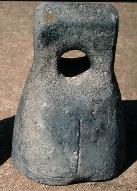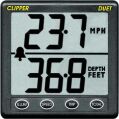The Sounding Lead
 |
Since at least the sixth century B.C. the
sounding lead or sounding weight was in use in the Mediterranean area for
maritime navigation. It is the oldest known marine navigational instrument
and it remained a primary navigational aid in coastal waters and rivers well
into the twentieth century.
A sounding weight is a roughly bell-shaped
mass, usually made of lead, averaging about five kilograms in weight, with
a sturdy attachment lug at its apex and a tallow cup in its spreading base.
A line was attached to the sounding lead (lead line) with graduated markings
at fixed length intervals. The sounding lead was led out in the water hanging
on the lead line and the line was veered until the lead reached the
sea bed. From the marks on the lead line the depth of water could be read.
|
Ancient mariners used sounding-weights,
not only to determine the depth of water, but also to bring up samples of
the bottom (stuck in the tallow on the base of the lead), comparing the result
with their knowledge of coastal geography and river sediments. With this
knowledge a method of navigating from one depth to another based upon the
condition of the bottom developed.
Herodotus wrote in the fourth century B.C.:
"..When you get 11 fathoms and ooze on the lead, you are a day's journey
out from Alexandria,..".
And a sailing directions from the 14th Century
reads "Ye shall go north until ye sound in 72 fathoms in fair grey sand.
Then north until ye come into soundings of ooze, and then go your course
east-north-east". 72 fathoms is about 130 meters - that's a long line!
From later reports we know that "heaving the
lead" was a standard procedure as a ship sailed into harbour. A sailor (the
"leadsman") would throw the sounding lead as far forward as he could, and
when the ship came up to where the lead had landed he would count the knots
or markings on the lead line and call out the depth of the water to the pilot.
|
 |
In 1895 Joshua Slocum - on his sailing journey around the world - passed
Sable Island (New Scotland - Canada) in a foggy night.
In his book "Sailing alone around the World" he writes:
"By the lead, which I cast often, I found that a little after midnight
I was passing the east point of the Island, and should soon be clear of
dangers of land ans shoals".
|
The Hand Lead Line
A hand lead line is a light sounding weight (7 to 14 pounds), usually having
al line of not more than 50 meters. It is used in coastal waters and anchorage
places to determine the depth of water and to bring up samples of the bottom.
Since modern yachts are equipped with electronic
sounding systems, the issue of analysing the anchorage soil is the main application
of lead lines today.
Nevertheless, the hand lead line will be used
in regular intervals to check and calibrate the installed sounding system.
This will be done especially for the critical shallow depths.
Acoustic Echo Sounding Systems
Modern electronic sounding systems are based
on ultrasonic echo transceivers. A short burst of an ultrasonic wave is transmitted
by an underwater transducer. A part of this acoustic wave will be reflected
by the sea bottom and this echo is received by the transducer.
The time elapsed between transmission and reception
of the acoustic burst is proportional to the distance travelled by this burst
from the transducer to the sea bottom and back. By measuring the time, the
acoustic wave needs to come back, the depth of the water below the transducer
can be measured.
In deep waters, secondary echoes may occur on
cold water layers. Since these echoes may be stronger than the main echo
coming from the bottom of the sea, a correct interpretation is difficult.
Only more expensive sounding systems will be able to give correct results.
Since this is only a problem for water depths well above 20 meters, this
is not an issue, for pleasure yachts.
 |
The advantage of an electronic sounding
system is that it enables a continuous and instantaneous monitoring of the
water depth. Especially when navigating shallow waters such as anchorages
or harbour entrances, this system is much more comfortable and safer than
working with the hand lead line.
Standard features of electronic sounding systems
include alarm functions, which will activate an acoustic signal, when the
measured depth is below a selected critical depth.
For use as anchorage alarm two critical depths,
defining an allowed depth range, can be selected. The alarm is activated
if the measured depth is not within the allowed range.
|
"Look-Ahead" Sounding Systems
Normal echo sounding systems determine the depth
of the water immediately below the underwater transducer. The transducers
are mounted such that they are aligned approximately along a plumb line.
With this constellation it is not possible to detect shallow waters in advance
- before the vessel has actually reached the shallow.
By tilting the transducer, such that it transmits
in a forward direction it is possible to measure the water depth of a point
which lies before the location of the vessel. This however requires additional
logical circuitry to calculate the depth from the time interval between burst
transmission and echo reception. Moreover this method requires more sensitive
transducers, since the received echo will be weaker. This will generally
result is a system, which is more prone to incorrect measurements. The increased
sensibility to environmental conditions has to be considered in the system
monitoring software, which must be able to recognize and ignore unreliable
transducer signals.
Recently effective "look-ahead" depth scanners
have been developed for maritime applications. They continously scan the
water depth in a range up to 100 meters ahead of the vessel producing a depth
profile, which can be displayed graphically on an LCD display.
|

